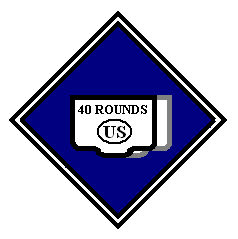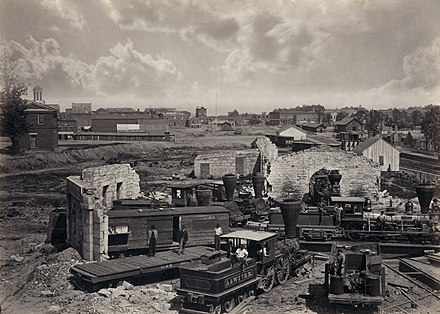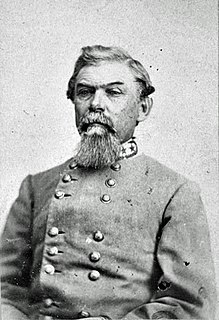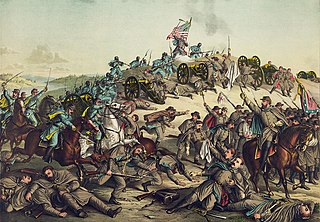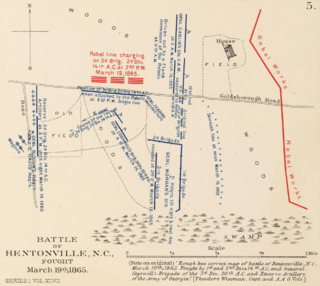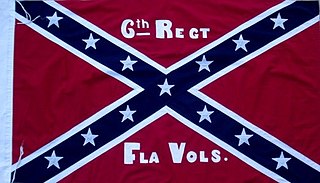| Atlanta Campaign | |||||||
|---|---|---|---|---|---|---|---|
| Part of the American Civil War | |||||||
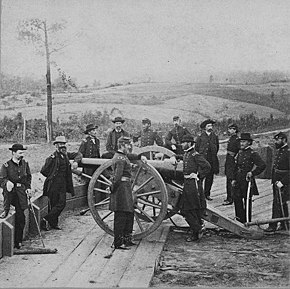 Union Maj. Gen. William T. Sherman and his staff in the trenches outside of Atlanta | |||||||
| |||||||
| Belligerents | |||||||
| Commanders and leaders | |||||||
| William T. Sherman | Joseph E. Johnston; replaced in July by John B. Hood | ||||||
| Units involved | |||||||
| Army of Tennessee [2] | |||||||
| Strength | |||||||
| 81,758–112,819 [3] | Beginning- 60.000 Infantry, 11,000 cavalry, 7,000 Artillery [4] | ||||||
| Casualties and losses | |||||||
| 31,687; (4,423 killed, 22,822 wounded, 4,442 missing/captured) | 34,979; (3,044 killed, 18,952 wounded, 12,983 missing/captured) | ||||||
The Atlanta Campaign was a series of battles fought in the Western Theater of the American Civil War throughout northwest Georgia and the area around Atlanta during the summer of 1864. Union Maj. Gen. William Tecumseh Sherman invaded Georgia from the vicinity of Chattanooga, Tennessee, beginning in May 1864, opposed by the Confederate general Joseph E. Johnston.

The Western Theater of the American Civil War encompassed major military operations in the states of Alabama, Georgia, Florida, Mississippi, North Carolina, Kentucky, South Carolina and Tennessee, as well as Louisiana east of the Mississippi River. Operations on the coasts of these states, except for Mobile Bay, are considered part of the Lower Seaboard Theater. Most other operations east of the Mississippi are part of the Eastern Theater. Operations west of the Mississippi River took place in the Trans-Mississippi Theater.

The American Civil War was a civil war fought in the United States from 1861 to 1865, between the North (Union) and the South (Confederacy). The most studied and written about episode in U.S. history, the Civil War began primarily as a result of the long-standing controversy over the enslavement of black people. War broke out in April 1861 when secessionist forces attacked Fort Sumter in South Carolina shortly after Abraham Lincoln had been inaugurated as the President of the United States. The loyalists of the Union in the North, which also included some geographically western and southern states, proclaimed support for the Constitution. They faced secessionists of the Confederate States in the South, who advocated for states' rights to uphold slavery.

Georgia is a state located in the southeastern region of the United States. Georgia is the 24th largest and 8th-most populous of the 50 United States. Georgia is bordered to the north by Tennessee and North Carolina, to the northeast by South Carolina, to the southeast by the Atlantic Ocean, to the south by Florida, and to the west by Alabama. The state's nicknames include the Peach State and the Empire State of the South. Atlanta, a "beta(+)" global city, is both the state's capital and largest city. The Atlanta metropolitan area, with an estimated population of 5,949,951 in 2018, is the 9th most populous metropolitan area in the United States and contains about 60% of the entire state population.
Contents
- Background
- Military situation
- Opposing forces
- Union
- Confederate
- Summary
- Battles
- Sherman vs. Johnston
- Sherman vs. Hood
- Aftermath
- Additional battle maps
- See also
- Notes
- References
- Memoirs and primary sources
- Further reading
- External links
Johnston's Army of Tennessee withdrew toward Atlanta in the face of successive flanking maneuvers by Sherman's group of armies. In July, the Confederate president, Jefferson Davis, replaced Johnston with the more aggressive General John Bell Hood, who began challenging the Union Army in a series of costly frontal assaults. Hood's army was eventually besieged in Atlanta and the city fell on September 2, setting the stage for Sherman's March to the Sea and hastening the end of the war.

The Army of Tennessee was the principal Confederate army operating between the Appalachian Mountains and the Mississippi River during the American Civil War. It was formed in late 1862 and fought until the end of the war in 1865, participating in most of the significant battles in the Western Theater.

Jefferson Finis Davis was an American politician who served as the only President of the Confederate States from 1861 to 1865. As a member of the Democratic Party, he represented Mississippi in the United States Senate and the House of Representatives prior to switching allegiance to the Confederacy. He was appointed as the United States Secretary of War, serving from 1853 to 1857, under President Franklin Pierce.

John Bell Hood was a Confederate general during the American Civil War. Hood had a reputation for bravery and aggressiveness that sometimes bordered on recklessness. Arguably one of the best brigade and division commanders in the CSA, Hood gradually became increasingly ineffective as he was promoted to lead larger, independent commands late in the war; his career and reputation were marred by his decisive defeats leading an army in the Atlanta Campaign and the Franklin–Nashville Campaign.












